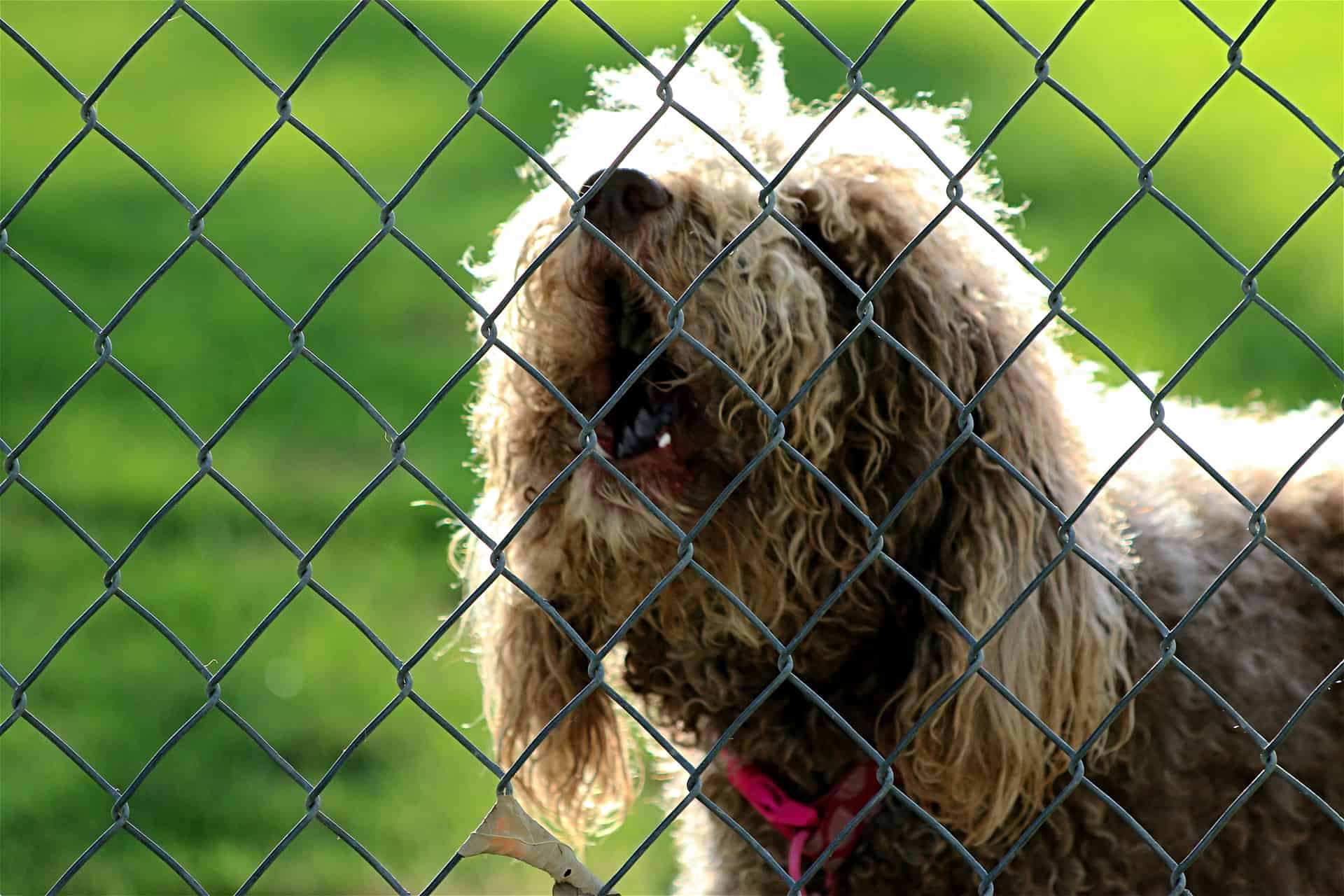Teaching Your Dog to Bark on Cue: Gaining Control
Training your pup to bark on cue can be a beneficial tool for obtaining control. It’s essential to ensure your dog knows when barking is acceptable and when it isn’t. Here’s how you can teach your pup to bark on cue and gain control:
- Excite and play with your pup.
- Say a cue such as “speak” or “bark“.
- Initiate barking by making fun noises or using a toy.
- Reward your pup with a treat or praise each time they bark on cue.
- Teach them the “quiet” command when it’s time to stop barking.
- Practice in various situations to make them understand when barking is alright.
- Be patient and consistent in training. Reward your pup for good behavior.
Understanding Dog Barking
Comprehending canine barking is crucial before teaching your pup to bark on command. Let’s explore why dogs bark, how to differentiate between types of barking and ways to manage their barking behaviour. Let’s dive in!
Different types of barks
Dogs bark to communicate. It could be because of a stranger, or needing something. There’re 4 main types:
- Alert barks – to signal something new or unusual in their environment.
- Play barks – to show they want to play.
- Fear barks – high-pitched sounds when feeling scared or threatened.
- Frustration barks – when hindered or ignored.
To teach your dog to bark on command, use a word like ‘speak’ and reward them each time they do it. Be patient and consistent. Teaching them is necessary to gain control of their behavior.
Why do dogs bark?
Dogs bark for lots of different reasons. These include communicating, expressing emotions, and warning their owners. Common reasons:
- Territorial Barking – to protect territory from strangers and animals.
- Attention-Seeking Barking – to get the owner’s attention.
- Fear-Induced Barking – when scared or anxious.
- Greeting Barking – when they see their owners or other familiar people.
It’s possible to train dogs to bark on command. This helps control their barking habits, and encourages them to bark when it’s appropriate. Pro Tip: Understanding your dog’s body language cues can also help you figure out why they are barking, and fix any issues.
Controlling excessive barking
Dogs bark for various reasons. But, loud barking can be annoying for you and your neighbors. You can train your pup to bark when you ask it to. Here are some tips:
- Understand why your pup barks. Is it scared, bored, or protecting?
- Train a “quiet” command. Say it each time your pup barks. Reward them when they stop.
- Train to bark on command. Use a verbal or physical cue. Then, reward them when they bark.
- Exercise and mentally stimulate your pup to avoid boredom.
- Consistency and patience are key. With effort, your pup will learn when to bark and when not to.
Basic Bark Training
Train your pup to bark on command – a skill they’ll find handy in many situations. It’s a great way to control their barking. Start with teaching them to bark when you say “speak” or with a gesture. Here are the basics of this kind of training!
- Choose the command you want to use.
- Teach your pup to bark on cue. Use your chosen command word, such as “speak”, and encourage your dog to bark using a toy or treat as a trigger. Say the command word, then use the toy or treat to get your dog to bark. Repeat this several times until your dog associates the command with the action of barking.
- Practice barking on command without the trigger. Once your dog understands the command, start phasing out the toy or treat trigger. Say the command word and wait for your dog to bark without the toy or treat. Reward them with praise or a treat when they bark on command.
- Vary the scenarios. Practice asking your dog to bark in different situations, such as when the doorbell rings or when a car drives up. This will help them learn to bark on command in many different situations.
Choosing a cue word
Selecting the ideal cue word is critical for teaching your pup to bark on command and obtaining control over their barking conduct. Here’s how to go about deciding the perfect cue word:
- Select a short and straightforward word. Pick a word that is easy for your dog to comprehend and remember, such as “bark” or “speak“.
- Utilize a steady word. As soon as you pick a cue word, remain with it. Consistency is vital in your pup’s learning process.
- Avoid general words. Abstain from utilizing words that your dog hears often, such as “no” or “stop“.
- Exercise with the cue word. Once you have chosen a cue word, utilize it reliably during training sessions, and reward your dog for barking on cue. With frequent practice, your dog will learn to link the cue word with barking conduct.
By following these suggestions, you can efficiently practice your dog to bark on cue and obtain control over their barking behavior.
Reward-based dog training
Reward-based dog training is a humane way to teach your dog commands & good behavior. Positive reinforcement, like treats, praise & playtime motivate your pup.
Basic bark training is a great place to start. Here’s how:
- Choose a word/phrase to use as a command for barking, e.g. “speak“.
- Wait for your dog to bark & then give the command “speak“. Reward them with a treat & praise!
- Repeat this multiple times. Your pup will eventually associate the command with barking.
- Practice the command in different situations & gradually increase the time between the command & bark.
- Never punish your dog for not responding. Be patient & use positive reinforcement. Pro tip – Use a clicker to mark & reward the desired behavior.
Positive reinforcement techniques
Positive reinforcement is key for bark training. Here are some tips to help you get control and train your pup:
- Pick a command word like “speak” or “talk” and use it every time.
- When your dog barks on their own, say the command and give them a treat or praise.
- Do this a few times a day, then decrease the treat or praise frequency.
- Once they’ve learned the command, use it in different situations to reinforce their behavior.
Remember, positive reinforcement works best with patience, understanding and love.
Obedience Training for Barking on Command
Gaining control of your pup’s bark? Teach them to bark on cue!
Obedience training can help your pet stay polite and not bark too much. Here are the steps you need to take:
- Get your dog to bark on command!
Consistent cue word training
Teaching your pup to obey commands, with cue words, is essential. Especially when it comes to barking on command.
Here’s how:
- Choose a simple, unique phrase like “Speak” or “Bark“.
- Tempt your pup to bark with treats.
- When they bark, immediately say the cue word, give them a treat and praise them.
- Repeat until they associate the word with barking.
- Gradually reduce treats and reward them with praise and attention.
- Once they can bark on command, use the cue word to control their barking. Reward them only when they bark on command.
Remember, consistent training and reinforcement of the cue word is a must for success.
Shaping behavior using rewards
Reward-based training is a great way to shape your pup’s behavior, including teaching them to bark and stop on command. Here are the key steps for obedience training:
- Choose a specific command, like “speak” or “bark.”
- Wait for your dog to bark naturally, then say the command while offering a treat.
- Repeat this a few times so your pup understands the command and the treat.
- To stop barking on command, wait for them to bark, then say “quiet” with the treat in hand.
- Reward when they stop barking.
- Consistent practice and patience is required.
Pro tip: Use positive reinforcement, never punish.
Encouraging controlled barking
Teaching your pup to bark on cue is a great way to encourage controlled barking and help manage their excessive barking or alert you of potential danger.
Choose a cue, like “speak” or “bark“, and say it in a clear and firm tone when they bark naturally.
Reward them immediately with a treat and a positive tone when they bark on cue.
Do this frequently and gradually increase the time between the cue and the response until they can bark without any prompting.
Keep rewarding them when they bark on cue and discourage barking outside of the cue. Give them praise when they’re quiet on command.
Remember to keep the sessions short, positive, and fun!
Advanced Bark Training Techniques
Your dog’s basic barking? All set? Splendid! Now, for the next step: advanced techniques!
Teaching your pooch to bark at your word has many benefits. We’ll explore methods to help you train your pup better. Let’s go!
Adding distractions during training
Distractions during training can help teach a pup to bark on cue. This advanced technique can be useful for those who bark excessively and don’t respond to typical training. Here’s what to do:
- Train your pup to bark on command in a distraction-free environment.
- Then, introduce minor distractions like toys or treats.
- Gradually, increase the level of distractions like loud noises or other animals.
- Reward your pup when they bark on command.
- Continue practicing with various distractions until they can bark on command in any situation.
Make sure that the distractions are safe and not too stressful for the pup.
Proofing obedience commands
Proofing obedience commands helps dogs reliably follow specific behaviors on command, even in distracting environments. Bark training needs proofing to teach a dog to bark when asked and remain quiet when commanded. Here is how to proof obedience commands:
- Practice in varied settings like parks or busy streets.
- Gradually make it harder. Start with basic obedience commands in a quiet place, then add more distractions.
- Use Positive Reinforcement. Praise or treats when the dog obeys.
- Consistency. Give the same command for the same behavior.
Properly proofed commands give you more control over barking and behavior, making them better behaved and reliable.
Impulse control and distractions
Control your dog’s barking with training. Dogs are easily distracted, so teaching them to pay attention to cues is key. Here are advanced techniques:
- Start with basic commands like ‘sit’ and ‘stay’. Repeat often and add distractions.
- Then teach them to bark on command. Give a hand signal or vocal cue and reward them with treats and praise.
- Increase the time between the cue and the bark, rewarding them for waiting.
- Practice in different environments and with distractions until they understand the command.
Bark training requires patience and consistency. With time and practice, your dog will learn to focus and follow commands.
Troubleshooting Common Issues
Troubleshooting is a must when teaching Fido to bark on cue. If your pup barks when you want quiet, or too late after the cue, here are some tips to help. Try these ideas to gain more control.
Overcoming fear or anxiety
Teaching your pup to bark on cue can be hard. Here are some tips to get control of the training:
- Start with basic obedience. Your dog should know “sit,” “stay” and “come.”
- Encourage with positive reinforcement. Use treats, praise and toys.
- Gradually make it harder. Start with something easy like knocking on a door.
- Create a positive environment. Keep the training session quiet and free from distractions.
- Get help from a pro. If you’re still struggling, get a professional trainer.
Addressing aggression or territorial barking
Aggression or territorial barking in dogs is a nuisance and sometimes even dangerous. Training your pup to bark on cue can help you have more control. Follow these steps:
- Say “speak” and give them a treat when they bark.
- Say “quiet” when they stop and give them a treat.
- Practice the commands in different situations with more distractions each time.
- Use the commands in situations where they are aggressive or territorial.
- With practice, rewards, and patience, teaching your dog to bark on cue can help you have better control of their barking.
Preventing excessive barking in puppies
Excessive barking in puppies can be a pesky problem. Teaching your pup to bark on cue is a great way to gain control and prevent too much barking. Here’s what you do:
- Choose a cue word or phrase – like “speak” or “talk”.
- When the pup barks, give the cue and reward them with a yummy treat.
- Repeat this multiple times, gradually reducing the amount of stimulation needed to get them to bark.
- Once they’ve learned to bark on cue, use it in situations where excessive barking may become an issue.
- Remember – patience, consistency, and rewards are key to teaching your dog any new behavior, including barking on cue.
Frequently Asked Questions
Q: Why is it important to teach my dog to bark on cue?
A: Teaching your dog to bark on cue can help you gain greater control over their behavior and better communication with them. It can also be useful for training, reading their body language, and helping them release pent-up energy.
Q: How do I begin training my dog to bark on cue?
A: Start by choosing a verbal cue and rewarding your dog for barking when you give the cue. Gradually increase the difficulty by adding distractions, such as someone at the door, and only giving the cue when you want your dog to respond.
Q: What are some tips for getting my dog to bark on cue?
A: Some tips include using a natural trigger, such as a doorbell or knock, to get your dog to bark, and reinforcing the behavior with positive rewards, like treats or playtime. It’s also important to use a consistent cue and practice regularly to maintain the behavior.
Q: Can teaching my dog to bark on cue lead to excessive barking?
A: Yes, it’s possible. That’s why it’s important to only cue your dog to bark when appropriate, such as in training sessions, and to reward them for quiet behavior as well. If your dog starts barking excessively, it may be a sign that you need to adjust your training approach.
Q: Is there any harm in teaching my dog to bark on cue?
A: There is no inherent harm in teaching your dog to bark on cue, as long as it’s done responsibly and in moderation. However, excessive barking can be annoying to those around you and lead to complaints from neighbors or even legal issues, so it’s important to be mindful of your dog’s barking behavior.
Q: How long does it take to teach a dog to bark on cue?
A: The time it takes to teach your dog to bark on cue can vary depending on the dog’s age, temperament, and previous training. Some dogs may learn quickly, while others may need more time and patience. Consistency and positive reinforcement are key to successful training.







